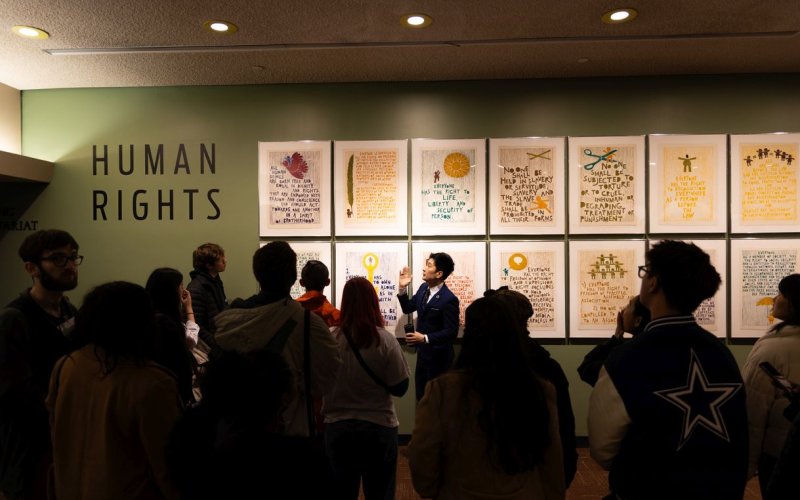From Collins Circle to the ‘Beating Heart’ of the World: UAlbany Students Visit the United Nations

ALBANY, N.Y. (April 29, 2025) — Forty students from University at Albany’s College of Integrated Health Sciences visited the United Nations Headquarters in New York City earlier this month. The trip is an annual event organized by John Justino, director of the UAlbany Center for Global Health and clinical associate professor at UAlbany’s Department of Health Policy, Management and Behavior.
“This trip serves as a great opportunity to help students gain a broader perspective and insight into today’s global challenges and see how countries can work together to solve them,” said Justino. “My hope is that students are able to take away some real-world knowledge while also making new connections through their shared experiences.”
A Tour of U.N. Headquarters
The visit started with a tour of the U.N. building overlooking the East River, where the group heard about the organization’s formation, history and an overview of the type of work the U.N. undertakes. The tour included stops at five of the six “organs” of the U.N. — the General Assembly, Security Council, Economic and Social Council, Trusteeship Council and the Secretariat — spaces which together house much of the organization’s activity.
“The tour was the best part of the trip, and I was blown away by their headquarters,” said Amelia Brown, a UAlbany sophomore studying public health. “I always saw the U.N. as a mystery and being beyond me, but after seeing the headquarters and its chambers where representatives discuss global issues, it really demystified things for me.”
One part of the tour that stood out to many of the students was the General Assembly Hall, the main deliberative and policy-making division where all 193 U.N. member nations convene and have an equal say in important global decisions.
“Seeing a space where all of the member countries have a seat at the table was awesome and inspiring. The hall was so grand; I don’t think I have ever seen anything like it,” said Genevieve Coonradt, a second-year Master of Social Work student.
The tour also highlighted various art pieces, many of which were gifts from other countries as a symbol of world peace and unity.
“I had never been to the United Nations before,” said Coonradt. “I was struck by the real sense of global connection in the building. From both employees and visitors, we saw so many different cultures represented and languages spoken.”
Sustainable Development Goals
Following the tour, the students participated in a briefing with Policy Specialist Roy Small, who is part of the HIV and Health Group within the United Nations Development Programme. The briefing focused on the organization’s 17 Sustainable Development Goals. These goals guide the U.N.’s efforts to “end poverty and inequality, protect the planet, and ensure that all people enjoy health, justice and prosperity.” The presentation featured U.N. research and a discussion on basic human rights and public health. Promoting health and well-being for all people of all ages was the central theme of the briefing.
As part of this session, the students took part in a debate about the strength of public health initiatives playing out in the world today. The COVID-19 pandemic was a focal point of the discussion and raised the question as to whether we are now better equipped to handle global public health emergencies, or if we are in fact more vulnerable in the event of another pandemic similar to COVID-19.
A portion of the briefing was dedicated to discussing U.N. research being done in parts of sub-Saharan Africa to assess the impact of cash transfer schemes on the risk among adolescent girls and young women for contracting HIV. The results showed that the cash transfer recipients stayed in school longer and their odds of becoming HIV-positive were lowered by as much as 25 percent. This helped the participants in the briefing to understand the complexity and interrelatedness of the U.N.’s Sustainable Development Goals (SDGs), in this case SDG 3 - Ensure healthy lives and promote well-being for all at all ages, SDG 4 - Ensure inclusive and equitable quality education and promote lifelong learning opportunities for all, and SDG 5 - Achieve gender equality and empower all women and girls.
“This research was very interesting,” said Brown. “It sheds light on the barriers to education in many African countries and shows us why this is a multifaceted issue that isn’t easily resolved. You can’t just build a school somewhere and expect it to heal all other educational roadblocks.”
The briefing session ended with a discussion question: Is the United Nations still needed? As a response to the many public health and human rights issues affecting the world today, the value of the organization has come into question. Our students were prompted to reflect on this question and share thoughts on its merits and shortcomings in the scheme of global affairs.
Global Experiential Learning
“The briefing was valuable because it is critical to stay current on what is happening in the world and to know what new information and data is being collected, no matter what field you work in,” said Justino “It is always beneficial to meet people who are actually practitioners right now, doing work in a field you want to be a part of.”
In his role at UAlbany, Justino works on global programs and with students interested in gaining global experiential learning opportunities. Justino has spearheaded this yearly field trip for roughly a decade, and this year he had the help of his graduate assistant, Shreya Bohara Chand, a 2024 UAlbany graduate with a bachelor of science in public health. She is currently a first-year Master of Public Health student focusing on epidemiology and maternal and child health at the College of Integrated Health Sciences.







